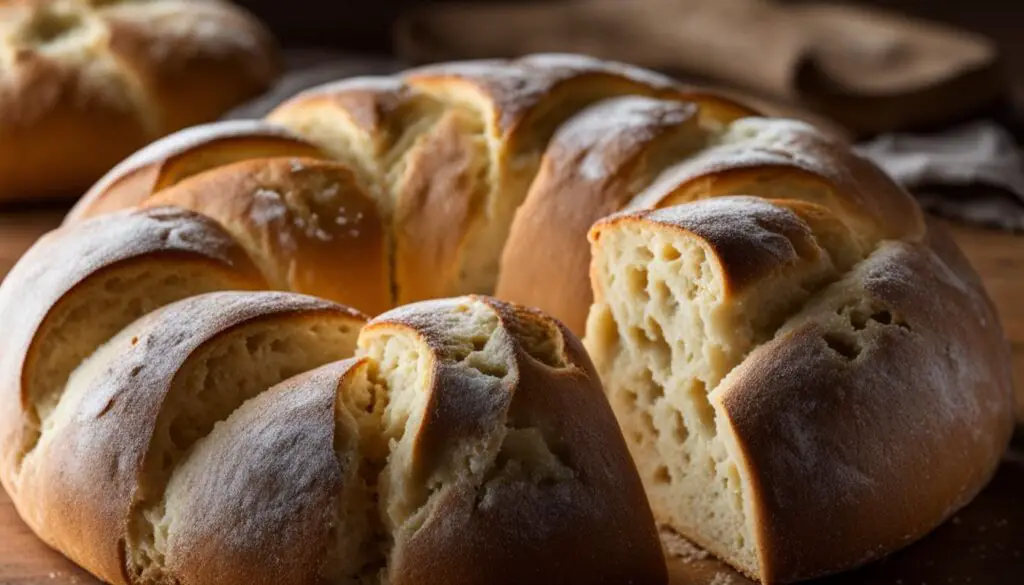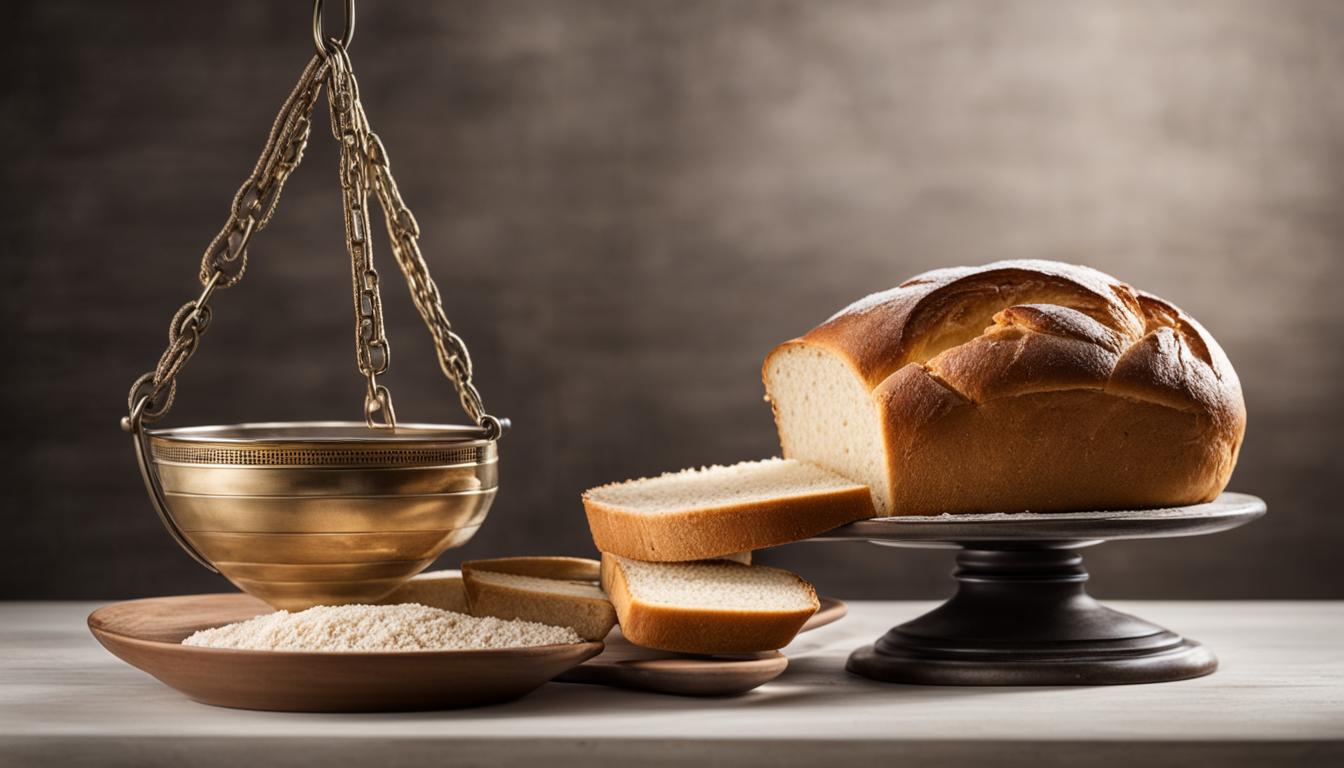Welcome to our deep dive into the biblical understanding of leaven. In this article, we will explore the definition, symbolism, and significance of leaven in the Bible. Leaven, commonly known as a substance used in bread-making, carries a much deeper meaning within biblical contexts.
Etymologically, the word “leaven” finds its roots in Hebrew (seor) and Greek (zyme). These terms refer to the fermentation process that leaven undergoes, which is crucial in making bread rise. But beyond its literal use in baking, leaven holds symbolic weight in scripture.
Throughout the Bible, leaven is mentioned in various contexts, often representing sin, corruption, and negative influences. From the teachings of Jesus to the writings of Paul, we see how leaven serves as a powerful metaphor for understanding and navigating our spiritual journeys.
Join us as we explore the biblical verses, stories, and interpretations surrounding leaven. We will also discuss the relevance of leaven in today’s world and the divergent opinions held by scholars and believers alike.
Key Takeaways:
- The Bible defines leaven as both a literal ingredient in bread-making and a powerful symbol of sin and corruption.
- Leaven is mentioned in various scriptures, including the teachings of Jesus and the writings of Paul.
- Understanding leaven requires delving into its biblical context and the different interpretations offered by scholars.
- Today, the relevance of leaven in the world is subject to individual beliefs and applications.
- Exploring the meaning of leaven provides insights into embracing righteousness, grace, and personal transformation.
Definition of Leaven
Leaven, as described in the Bible, is a substance used in bread-making that holds both literal and symbolic significance. In its literal sense, leaven refers to a lump of old dough in a highly fermented state, which is then mixed into fresh dough to facilitate the rising process. It plays a crucial role in the creation of bread, cakes, and other baked goods, allowing them to become light and fluffy. This literal definition of leaven helps us understand its symbolic implications when used in a biblical context.
The English word “leaven” derived from the Latin “levare,” meaning “to raise” or “to lighten.” The Hebrew term for leaven is “se’or,” while the Greek word is “zyme.” These etymological roots further emphasize the concept of raising or fermenting dough. In the Scriptures, leaven is used metaphorically to represent sin, corruption, and negative influences. It serves as a reminder of the pervasive nature of sinful behavior and the need for spiritual cleansing and renewal.

“Do you not know that a little leaven leavens the whole lump? Cleanse out the old leaven that you may be a new lump.” – 1 Corinthians 5:6-7
This quote from the Apostle Paul’s letter to the Corinthians vividly illustrates the transformative power of removing leaven, not only in the context of bread-making but also in the spiritual realm. Just as a small amount of leaven can permeate an entire batch of dough, sin has the potential to corrupt and influence every aspect of our lives if left unchecked. The biblical definition of leaven calls us to examine our hearts, identify areas of sin, and strive for purity and righteousness.
| Old Testament | New Testament |
|---|---|
| Leavened bread is prohibited during the Feast of Unleavened Bread (Exodus 12:8) | Jesus uses leaven as a metaphor in his teachings (Matthew 16:6, Mark 8:15) |
| The removal of leaven symbolizes the removal of sin during the Feast of Unleavened Bread (Exodus 12:15) | Paul warns against the spread of sin within the church and encourages the removal of old leaven (1 Corinthians 5:6-8) |
Throughout the Bible, leaven is employed to convey profound spiritual truths. From the Feast of Unleavened Bread in the Old Testament to the teachings of Jesus and Paul in the New Testament, it serves as a potent symbol of sin, corruption, and the need for repentance. By understanding the biblical definition of leaven, we can gain deeper insights into God’s message and strive to live lives that are free from the leaven of sin.
Leaven in the Bible
Leaven holds significant symbolic meaning in the Bible and is mentioned in various contexts throughout scripture. Often representing sin and corruption, leaven serves as a powerful metaphor in understanding the message conveyed. Let’s explore some notable biblical references to leaven and delve into their scriptural understanding.
Biblical References to Leaven
In 1 Corinthians 5:6-8, the apostle Paul urges the Corinthians to cleanse out the old leaven of malice and evil, emphasizing the importance of sincerity and truth. Jesus also uses the metaphor of leaven in his teachings, notably in the Parable of the Leaven found in Matthew 13:33 and Luke 13:20-21. In this parable, he compares the Kingdom of Heaven to a woman mixing leaven into a large amount of flour, illustrating the growth and spread of the church.
Furthermore, leaven is mentioned in the context of the Feast of Unleavened Bread in Exodus. During this feast, the Israelites were commanded to remove all leaven from their houses and consume only unleavened bread. This act symbolized their hasty departure from Egypt and their readiness to follow God’s commands.
Key Takeaways
The scriptural understanding of leaven reveals its association with sin, corruption, and the need for purification. It serves as a reminder to believers to cleanse themselves of negative influences and embrace righteousness and truth. Through various biblical stories, metaphors, and commands, leaven conveys important lessons about spiritual growth, transformation, and the impact of one’s actions.
However, it is crucial to note that interpretations of leaven may vary among individuals and different theological perspectives. While some may see parallels between leaven and negative influences in today’s world, others may find different applications based on their beliefs and contexts.

| Biblical Reference | Meaning |
|---|---|
| 1 Corinthians 5:6-8 | Urge to cleanse out old leaven and embrace sincerity and truth |
| Matthew 13:33; Luke 13:20-21 | Comparison of the Kingdom of Heaven to leaven spreading through flour |
| Exodus – Feast of Unleavened Bread | Symbolic removal of leaven to commemorate the Israelites’ departure from Egypt |
Leaven in Exodus
The mention of leaven in the book of Exodus holds significant symbolism in the context of the Feast of Unleavened Bread. According to biblical accounts, the Israelites were commanded to eat unleavened bread during this feast, which commemorated their hasty departure from Egypt. As part of their preparations, they removed all leaven from their households and baked bread without it. This act represented their readiness to embark on their journey and leave behind the corrupting influence of Egypt.
The use of unleavened bread during the Feast of Unleavened Bread served as a powerful symbol of purity, freedom, and obedience to God’s commandments. It reminded the Israelites of their deliverance from bondage and their commitment to live righteous lives. This tradition continues to be observed by many Jewish communities to this day.
| Feast of Unleavened Bread in Exodus | Symbolism |
|---|---|
| The Israelites removed all leaven from their households | Represented their readiness to leave Egypt |
| They baked bread without leaven | Symbolized purity and obedience |
| The tradition continues to be observed by Jewish communities | Reinforces the significance of the Exodus and commitment to righteousness |
In addition to the Feast of Unleavened Bread, leaven is also mentioned in other contexts throughout Exodus. For example, leaven is prohibited in all offerings and sacrifices made to God, except during the Feast of Weeks, when two loaves of bread made with leaven are presented as a wave offering. This exception highlights the unique nature of the occasion and further underscores the symbolic significance of leaven in biblical rituals.
The mentioning of leaven in Exodus demonstrates the importance of understanding its deeper meaning in biblical contexts. It serves as a reminder of the Israelites’ liberation from Egypt and their commitment to a life free from the corrupting influence of sin. The symbolism of leaven continues to resonate in religious observances and provides valuable insights into the spiritual teachings of the Bible.
Offerings and Sacrifices
When it comes to offerings and sacrifices in the Bible, leaven had specific rules and restrictions. Generally, leaven was not allowed to be used in any offerings or sacrifices made to God. This prohibition emphasized the need for purity and the removal of sin from the worshipper’s life. However, there was one exception to this rule during the Feast of Weeks.
The Feast of Weeks:
| Feast | Leavened or Unleavened | Purpose/Significance |
|---|---|---|
| Feast of Weeks | Leavened | Offering of two loaves of bread |
During the Feast of Weeks, also known as Pentecost, the Israelites were commanded to offer two loaves of bread made with leaven as a wave offering. This was a unique occasion where leavened bread was permitted as an offering to God. The two loaves represented the firstfruits of the harvest and symbolized the abundance and blessing bestowed upon God’s people.
This exception in the use of leaven during the Feast of Weeks highlighted the significance of the occasion and the celebration of the harvest. It served as a reminder of God’s provision and the joyous gathering of the community to worship and give thanks.
Overall, the use of leaven in offerings and sacrifices underscored the importance of purity and the removal of sin. The exceptional allowance of leaven during the Feast of Weeks revealed the deeper symbolism associated with this festival. It reminded the Israelites of their dependence on God’s provision and the unity of the community in celebrating His blessings.
Jesus and Leaven
Jesus frequently used metaphors and parables to convey important spiritual truths to his disciples and followers. One of the metaphors he employed was that of leaven. In the teachings of Jesus, leaven symbolized the growth and spread of the Kingdom of Heaven. He used this metaphor to warn against the hypocrisy and false teachings of the religious leaders of his time.
“The Kingdom of Heaven is like yeast that a woman took and mixed into about sixty pounds of flour until it worked all through the dough.” (Matthew 13:33, NIV)
“Be on your guard against the yeast of the Pharisees, which is hypocrisy.” (Luke 12:1, NIV)
In the Parable of the Leaven, Jesus compared the Kingdom of Heaven to a woman mixing leaven into a large amount of flour. Just as a small amount of leaven can cause the dough to rise and expand, so too can the influence of the Kingdom of Heaven transform and impact the world. This metaphor reminds believers that the power and influence of God’s truth can spread throughout society, bringing about positive change and growth.
By using the imagery of leaven, Jesus challenged his listeners to examine their own lives and the teachings they followed. He encouraged them to be vigilant and discerning, avoiding the corrupting influence of false teachings and religious hypocrisy. Instead, he emphasized the importance of embracing sincere faith and truth, which have the power to transform individuals and communities.
Table: Leaven in the Teachings of Jesus
| Scripture | Message |
|---|---|
| Matthew 13:33 | The Kingdom of Heaven is like yeast that works through the dough. |
| Luke 12:1 | Watch out for the hypocrisy of the religious leaders. |
Paul and Leaven
Paul, one of the prominent figures in the New Testament, also used the metaphor of leaven in his teachings. In 1 Corinthians 5:6-8, he cautions the believers about the corrupting influence of sin within the church. He urges them to remove the old leaven, symbolizing the need to cleanse themselves from malice and wickedness. Paul emphasizes the importance of living a life of sincerity and truth, free from the leaven of sin.
Moreover, Paul also highlights the transformative power of God’s grace in his analogy of leaven. Just as a small amount of leaven can spread throughout a large amount of dough and cause it to rise, Paul compares God’s grace to leaven that can permeate and transform the entire church. This signifies that through grace, believers can experience a radical change in their lives, leaving behind the influence of sin and embracing a renewed way of living.
“Do you not know that a little leaven leavens the whole lump? Cleanse out the old leaven that you may be a new lump, as you really are unleavened. For Christ, our Passover lamb, has been sacrificed. Let us therefore celebrate the festival, not with the old leaven, the leaven of malice and evil, but with the unleavened bread of sincerity and truth.” – 1 Corinthians 5:6-8
The Symbolism of Leaven
Throughout Paul’s teaching, leaven serves as a symbol of sin and its pervasive nature. It signifies the potential for evil to infiltrate and corrupt the community of believers. However, Paul also emphasizes that just as leaven can spread and transform the dough, God’s grace has the power to transform lives and bring about redemption.
Leaven as a Symbol of Sin and Grace
The metaphor of leaven in Paul’s teachings highlights the dichotomy between sin and grace. It reminds believers to be vigilant against the influence of sin and to embrace the transformative power of God’s grace. By removing the old leaven of malice and evil and embracing sincerity and truth, believers can experience a renewed and righteous way of life.
Table: Comparing the Symbolism of Leaven in Paul’s Teachings
| Symbol | Sin | Grace |
|---|---|---|
| Effect | Corrupts and spreads | Transforms and redeems |
| Influence | Evil and malice | Sincerity and truth |
| Power | Destructive | Redemptive |
https://www.youtube.com/watch?v=Urvh_3XMmgE
Paul’s teachings on leaven offer valuable insights into the nature of sin and the transformative power of God’s grace. It reminds believers to remain vigilant against the corrupting influence of sin and to embrace the redemptive power of grace. Through the removal of the old leaven of malice and evil, and the adoption of sincerity and truth, believers can experience a renewed life in Christ.
Leaven as Sin, Influence, and Wickedness
The symbolic significance of leaven in the Bible extends beyond its role in bread-making. It represents sin, influence, malice, and wickedness. Just as a small amount of leaven can permeate and transform an entire batch of dough, these negative qualities can spread and corrupt individuals and communities.
Leaven as sin is highlighted in various scriptures, emphasizing the need for believers to cleanse themselves of sinful thoughts and actions. In Matthew 16:6, Jesus warns his disciples to beware of the leaven of the Pharisees and Sadducees, referring to their hypocrisy and false teachings. The presence of sin can distort one’s perception of truth and lead others astray.
Furthermore, leaven serves as a symbol of influence. Just as leaven affects the entire dough, our words and actions have the power to impact those around us. In 1 Corinthians 15:33, Paul states, “Do not be deceived: ‘Bad company ruins good morals.’” This verse emphasizes the importance of surrounding ourselves with positive influences and avoiding the destructive effects of negative associations.
Leaven also represents malice and wickedness. In Galatians 5:9, Paul warns against allowing a “little leaven” to leaven the whole lump, referring to the corrupting influence of malice and wickedness within the church community. It serves as a reminder to be vigilant in guarding against the spread of these negative qualities, both individually and collectively.
| Leaven Symbolism | Bible Verse |
|---|---|
| Sin | Matthew 16:6 |
| Influence | 1 Corinthians 15:33 |
| Malice and Wickedness | Galatians 5:9 |
Understanding leaven as sin, influence, malice, and wickedness allows us to recognize the potential dangers lurking within ourselves and society. It prompts us to examine our thoughts, words, and actions, striving for righteousness and resisting the negative forces that seek to corrupt and divide. By choosing love, truth, and integrity, we can counteract the effects of leaven and contribute to a more harmonious and morally sound world.
Leaven in the Feast of Unleavened Bread and Festival of Weeks
The Feast of Unleavened Bread holds great significance in the Bible, particularly in the Jewish tradition. It is a commemoration of the Israelites’ hasty departure from Egypt, and the removal of leaven is an essential part of observing this feast. This removal symbolizes the removal of sin and corruption from their lives.
In Exodus 12:18-20, God commands the Israelites, “In the first month, on the fourteenth day of the month at evening, you shall eat unleavened bread, until the twenty-first day of the month at evening. For seven days no leaven is to be found in your houses.” This period of seven days during which only unleavened bread is eaten is known as the Feast of Unleavened Bread.
During this week-long feast, the Israelites would diligently search their homes for any trace of leaven and remove it. This act of removing leaven was a physical representation of their desire to rid themselves of sin and corruption, both personally and collectively. It served as a reminder of their liberation from Egyptian bondage and their commitment to live in obedience to God.
“The removal of leaven from the homes of the Israelites was more than a mere religious observance. It was a tangible way of illustrating their obedience to God’s command and their willingness to be set apart as a holy people.”
The Festival of Weeks, also known as Pentecost, is another occasion where leavened bread plays a specific role. According to Leviticus 23:17, during this festival, two loaves of leavened bread were to be offered as a wave offering to God. This offering represented the firstfruits of the harvest and was a symbol of the Israelites’ gratitude for God’s provision.
While the general prohibition of leaven in offerings and sacrifices highlights its association with sin and corruption, the inclusion of leavened bread in the Festival of Weeks serves as a special exception. It is a recognition of the unique nature of this celebration and a reminder that God’s blessings and grace are not limited by the presence of leaven.
In summary, the Feast of Unleavened Bread and the Festival of Weeks are significant occasions in the Bible where leaven plays a distinct role. The removal of leaven during the Feast of Unleavened Bread symbolizes the removal of sin and corruption, while the offering of leavened bread during the Festival of Weeks represents gratitude and the recognition of God’s provision.
| Feast | Leaven |
|---|---|
| Feast of Unleavened Bread | No leaven is to be found in houses for seven days |
| Festival of Weeks | Two loaves of leavened bread offered as a wave offering to God |
Leaven in Today’s World
The concept of leaven continues to hold symbolic significance in biblical contexts, but its relevance in today’s world may vary depending on individual interpretations and beliefs. While some may draw parallels between the metaphor of leaven and the negative influences present in modern society, others may find different applications for its meaning.
In contemporary context, leaven can be seen as representing the pervasive nature of sin, corruption, and negative influences in the world. Just as leaven spreads throughout dough, these negative elements can permeate various aspects of society, from individual behaviors to systemic issues. Acknowledging the existence of these forces can prompt individuals to actively work towards righteousness and counteract their detrimental effects.
On the other hand, some may argue that the metaphor of leaven is no longer applicable in today’s world. They may contend that society has progressed and that the influence of sin and corruption is not as prevalent as it was in ancient times. These individuals may prioritize other values and beliefs in shaping their understanding of contemporary challenges and the means to address them.
| Relevance | Points of View |
|---|---|
| Continued Symbolism |
|
| Evolving Interpretations |
|
“The metaphor of leaven invites us to reflect on the impact of negative influences and the importance of actively countering them in our lives and communities.” – Dr. Sarah Thompson, biblical scholar
Ultimately, the interpretation and relevance of leaven in today’s world are subjective and depend on individual perspectives. It is up to each person to explore its meaning within their own faith and understanding. Whether one sees leaven as a powerful symbol of sin and corruption or as a metaphor that needs reinterpretation, the broader message remains: to strive for righteousness and actively work towards positive change in the world.
Conclusion
The biblical interpretation of leaven is multi-faceted and carries symbolic significance throughout the Bible. Understanding its true meaning requires a deep dive into its various mentions and contexts.
Leaven, in its literal sense, refers to a substance used in bread-making to make dough rise. However, beyond its culinary role, leaven is frequently used as a metaphor for sin, corruption, influence, and transformation in the scriptures.
By exploring biblical verses and stories, we discover that leaven represents the negative qualities that believers are encouraged to cleanse themselves of. It serves as a powerful reminder to live in righteousness, truth, and grace.
While interpretations of leaven in today’s world may vary, the understanding of leaven in the Bible remains relevant and timeless. It prompts reflection on the impact of negative influences and challenges us to embrace a life of righteousness and transform our communities for the better.
FAQ
What is the biblical definition of leaven?
Leaven is a substance used in bread-making that also has symbolic meaning in the Bible. It represents sin and corruption.
Where is leaven mentioned in the Bible?
Leaven is mentioned in various parts of the Bible, including 1 Corinthians, Matthew, Luke, and Exodus.
What does leaven symbolize in the Feast of Unleavened Bread?
In the Feast of Unleavened Bread, leaven symbolizes sin and corruption. The removal of leaven represents the removal of these negative qualities.
Was leaven allowed in offerings and sacrifices?
Leaven was generally not allowed in offerings and sacrifices, except during the Festival of Weeks, where leavened bread was offered as a wave offering.
How does Jesus use the metaphor of leaven?
Jesus uses the metaphor of leaven to warn against hypocrisy and false teachings, and to illustrate the growth and spread of the church.
How does Paul use the metaphor of leaven?
Paul uses the metaphor of leaven to warn against the spread of sin within the church and to highlight the transformative power of God’s grace.
What does leaven symbolize in the Bible?
Leaven symbolizes sin, influence, malice, and wickedness. It serves as a reminder for believers to live in righteousness and truth.
What is the significance of leaven in the Feast of Unleavened Bread and Festival of Weeks?
In the Feast of Unleavened Bread, the removal of leaven symbolizes the removal of sin and corruption. In the Festival of Weeks, leavened bread is offered as a wave offering to God, representing a special occasion.
Does leaven have relevance in today’s world?
The relevance of leaven in today’s world may vary depending on individual interpretations and beliefs.
How should leaven be understood in the Bible?
Understanding leaven in the Bible requires a deep dive into its various mentions and contexts, exploring its literal and symbolic meanings.








Leave a Reply